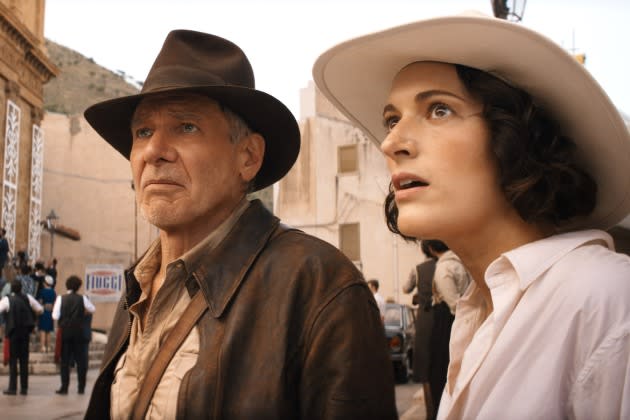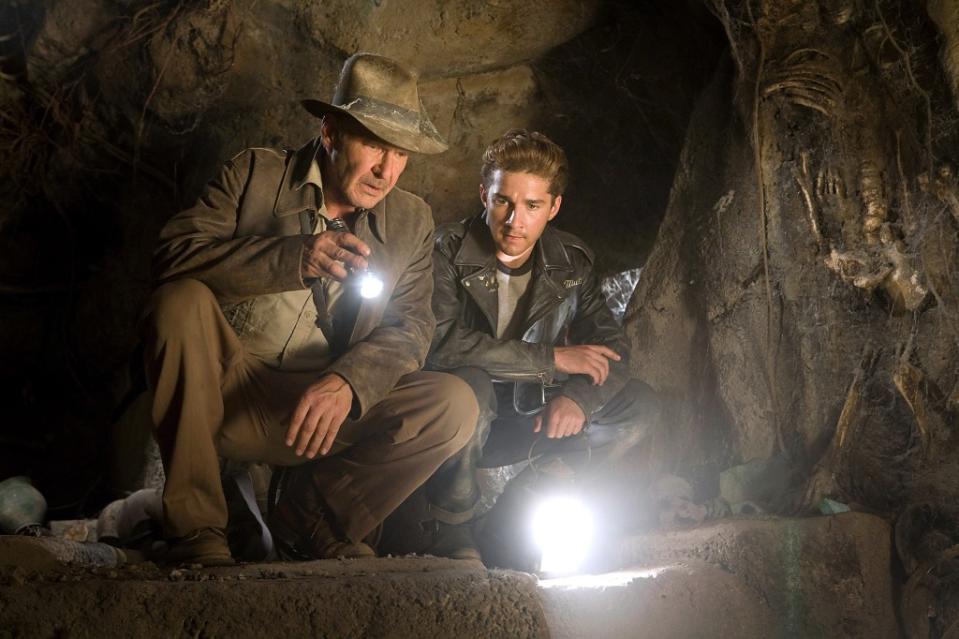‘Indiana Jones 5’ Director James Mangold Explains the Fate of Shia LaBeouf’s Character and the ‘Wild Swing’ Ending
- Oops!Something went wrong.Please try again later.
- Oops!Something went wrong.Please try again later.
- Oops!Something went wrong.Please try again later.

SPOILER ALERT: This story discusses major plot developments, including the ending, of “Indiana Jones and the Dial of Destiny,” currently playing in theaters.
When director James Mangold started writing “Indiana Jones and the Dial of Destiny” with screenwriters Jez and John-Henry Butterworth, he didn’t know how the movie was going to end. Mangold inherited the film from director Steven Spielberg, who had been developing the project for three years with screenwriter David Koepp. When Mangold took over, he and the Butterworths started effectively from scratch, crafting a story in which Harrison Ford’s titular archeologist and Nazi puncher contends with his own age and irrelevance while chasing after the Antikythera, a mysterious device with the power to find fissures in time, created by the ancient Greek mathematician and inventor Archimedes.
More from Variety
Initially, the screenwriting team thought about ending the movie by returning to the film’s extended prologue in 1944, when a younger Indy and the film’s villain, Nazi scientist Jürgen Voller (Mads Mikkelsen), first encounter the Antikythera on a Nazi loot train. And indeed, the film’s second act does end with Voller obtaining the device, kidnapping Indy, and flying off in a WWII-era Nazi gunship to travel back in time so Voller can win the war for Germany.
Except, Mangold says, he realized he didn’t want do to that.
“I couldn’t find a way to wrap my head around going back to the past and stopping Mads from doing his nefarious deeds to continue the Third Reich,” Mangold told Variety in early June. “It lacked wonder and was going to turn into kind of a cat and mouse thing. I felt like we’d be better off if that’s what people are anticipating, but that we really pull the tablecloth out from under the dishes at the last minute.”
At the same time, Mangold knew that if you’re going to have a device that can help its user manipulate time, “You’re going to have to see the power.” So rather than go back to WWII, Mangold and the Butterworths looked to Archimedes for their ending, and sent Indy and Voller — as well as Indy’s compatriots Helena (Phoebe Waller-Bridge) and Teddy (Ethann Isidore) — back to the Roman siege of Archimedes’ home of Syracuse on the island of Sicily in roughly 213 BCE.
The moment is foreshadowed early in the film, when we see Indy lecturing a class of indifferent college students about how Archimedes invented a series of ingenious mechanisms to repel the invading Roman navy. Mangold saw in the ending a chance to give Indy the opportunity — after a lifetime spent seeking out relics of bygone eras in history — to actually witness that history first hand.
“He’s suddenly in the midst of it,” the director said. “I also thought it presented us with a kind of audacious turn which I thought was a staple of these movies.”
Putting a Nazi warplane alongside a fleet of Roman triremes is certainly a big swing, but Mangold thought it of a piece with the climaxes of 1981’s “Raiders of the Lost Ark” and 1989’s “Indiana Jones and the Last Crusade.”
“It’s no more of a wild swing in my mind than ghouls flying out of a box and melting people’s heads through the sheer power of dark angels, or a 700-year-old knight existing in a cave for perpetuity,” Mangold said. “These are all beyond the scope of all physical belief.”
More importantly, it provided Indy with a chance to express an almost existential grief. We learn in “The Dial of Destiny” that Indy’s son, Mutt Williams — first introduced in 2008’s “Indiana Jones and the Kingdom of the Crystal Skull,” as played by Shia LaBeouf — was killed in the Vietnam War, and the anguish over that loss shattered Indy’s marriage to his beloved Marion Ravenwood (Karen Allen). As an injured Indy looks over the battlefield, he tearfully tells Helena that he doesn’t want to go back to his home in 1969. He believes he has nothing to go home to.
“That seemed to me to be right emotionally,” Mangold said, “that a disillusioned hero could end up at this wonderful tumultuous moment in world history and — with his son gone and his wife gone — that he’d picture himself staying in the place he loves best, which is this imagining these worlds.”

The decision to kill off Mutt evokes some baggage that has nothing to do with “The Dial of Destiny.” Two years after the release of “Crystal Skull,” LaBeouf told the Los Angeles Times that the movie “dropped the ball” and that “there was a reason it wasn’t universally accepted.” In 2016, LaBeouf went even further, telling Variety that “I don’t like the movies that I made with Spielberg,” and that he found working with the filmmaker to be disillusioning: “He’s less a director than he is a fucking company.”
But Mangold said LaBeouf’s scorched earth interviews did not factor into his decision about Mutt’s fate.
“It’s separate from all past studio, political intrigue on movies I didn’t make,” he said. “You were either going to make a movie all about the two of them” — meaning, Indy and Mutt — “or you’re going to have to find a way to not have [Mutt] around, because he was too significant a player in the previous film to just pretend he didn’t exist.” Besides, Mangold said, “I didn’t think his whole thing worked that well in the previous film. I just went towards something else because it was what was more interesting to me.”
For Mangold, that was getting to explore what it meant for Indy to look back a lifetime of regret and loss and find himself ready to disappear into history, quite literally. But he also never entertained the possibility of fulfilling Indy’s desire to stay behind.
“Unless we established him healing and setting up shop and remarrying and finding a beautiful Sicilian house to live in — I guess there was a way of doing it, but I didn’t imagine it,” he said. “I felt like he had to come home. He had to clean things up. He had to own what happened to him and Marion, and the amount of loneliness and disappointment in himself he’s carrying about his inability to navigate that between them.”
With Indy intractably set on remaining stuck in antiquity, Helena cold cocks him to get back on the plane and through the time fissure so they can all return to 1969. In the next scene, he wakes up in his New York City apartment, and discovers that Helena has called Marion and convinced her to come back to see him again.
Asked about working with Karen Allen, Mangold broke into a wide grin.
“She’s so wonderful,” he said. “She’s such a beautiful soul. And I can’t imagine how hard it was for her because she’s stepping into a movie that had been shooting for a long time. But it was really moving to me.”
The film ends with a reprise of the famous scene from “Raiders of the Lost Ark,” when an injured Indy cajoles Marion into kissing the parts of his body that don’t hurt. In “The Dial of Destiny,” the roles are reversed, with Indy tenderly apologizing for the heartache he’s caused Marion, and kissing the parts of her she says don’t hurt.
Mangold credits the Butterworths for coming up with the callback. “I thought it was just brilliant,” Mangold says. “I didn’t know what to do. It just seemed like a gift the second they showed me this idea. It’s one of the great encapsulations of their relationship and a memory that everyone knows the second they hear that, ‘Where?’ They remember that movie.”
Best of Variety
Sign up for Variety’s Newsletter. For the latest news, follow us on Facebook, Twitter, and Instagram.

